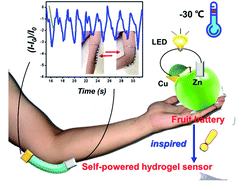Fruit-battery-inspired self-powered stretchable hydrogel-based ionic skin that works effectively in extreme environments†
Abstract
Strain sensors and bionic skin made of hydrogels have been rapidly developed for use in human motion detection. However, the realization of self-powered sensing using hydrogels has huge application prospects and challenges. Herein, a fruit-battery-inspired economical self-powered hydrogel-based sensor was designed and fabricated, and it integrates high stretchability (∼830%), a skin-like Young's modulus (∼30 kPa), good electrical conductivity (∼5.3 S m−1), anti-drying and anti-freezing (−47.92 °C) properties, transparency (92.92%, thickness: 3 mm), and a suitable output voltage (∼0.55 V). More importantly, a new self-powered strain sensing mechanism based on this hydrogel was proposed. The self-powered hydrogels can respond to pressure and strain signals through output current changes without the use of an external power supply. Finally, self-powered ionic skin consisting of 8 hydrogel sensor units was assembled and it achieved a maximum output voltage of ∼4.4 V. The ionic skin can provide emergency power for types of small equipment (LED bulbs and buzzers). This study provides new concepts and ideas for self-powered sensors that are suitable for use in extreme environments.



 Please wait while we load your content...
Please wait while we load your content...